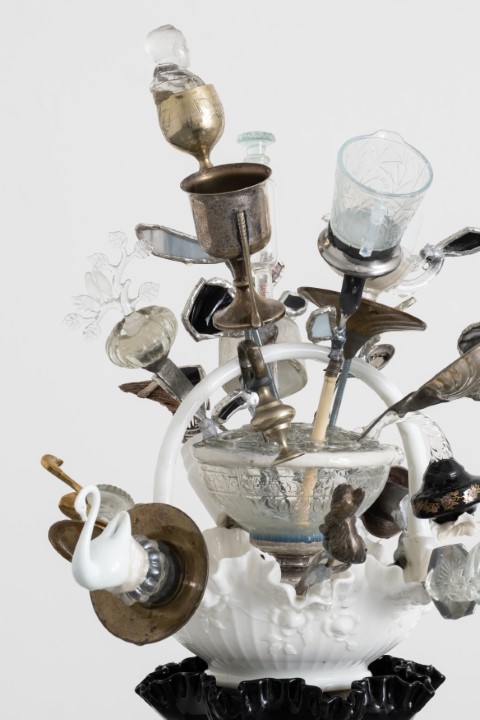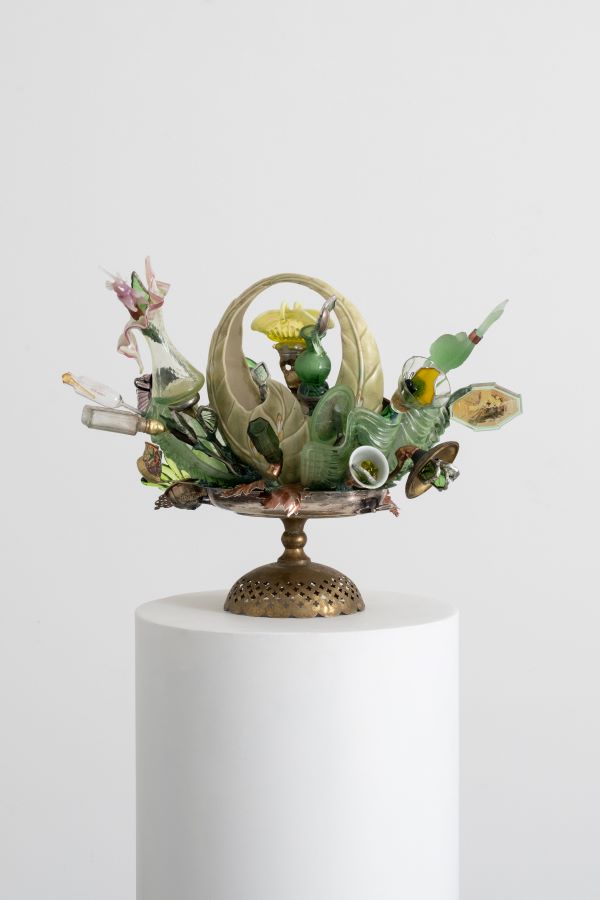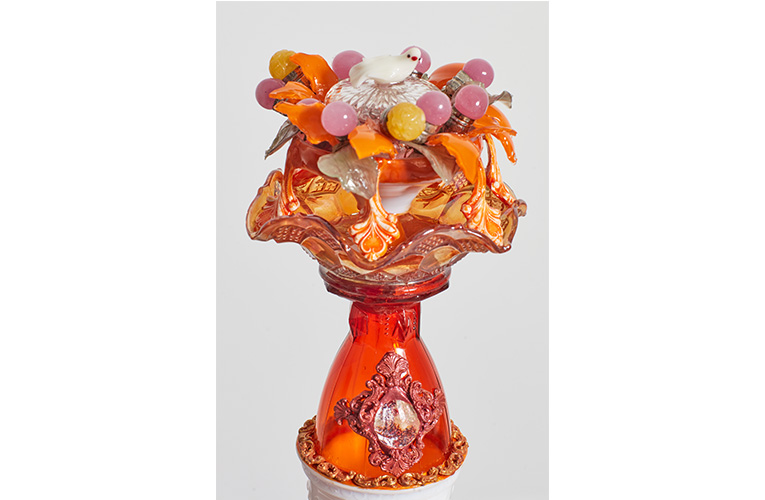Stephané Edith Conradie’s exhibition Wegwysers Deur Die Blinkuurat Standard Bank Gallery in Johannesburg promises to transport viewers into another realm
By Edward Tsumele, CITYLIFE/ARTS Editor
This year I attended the National Arts Festival. Having obviously noted down a selection of shows that I aimed at attending. A noble plan really, but such plans are hard to stick to as once there your original plans can simply, suddenly change in a fleeting moment. This is because once there you meet and mingle with other people who are likely to suggest their own favourite shows. Such advice is often good to take, but not always.
Fortunately for me this year one of the shows I had aimed at seeing was an exhibition by Stephané Edith Conradie, an academic and practising artist. I had met her last year at a function hosted the festival organisers to unveil the Standard Bank winners for 2023. Conradie was one of them having pocketed the Standard Bank Young Artist Award for visual art. And so fortunately I did not need any convincing by anyone to visit her show at the Settlers Monument. What I experienced, and not just seeing, was a stunning installation that featured various objects, most of them recovered objects. The sound installation somehow had the effect of transporting one into another realm. It felt spiritual.

I was therefore happy that even though I had a tight schedule for the three and half days that I spent there, and even though someone suggested that I could still see her exhibition in Johannesburg, being a Joburger myself, if I chose to not miss it at Makhanda. I insisted on seeing it there. A different location gives you a different artistic experience, including the space in which it is taking place and how the objects are arranged will always be different in different locations and different spaces for the same show. In other words, the way the building in which the exhibition is taking place is laid out determines the curatorial choices that the curator makes. For instance, the way the Monument room in which this exhibition took place t gave it a feeling of being in another realm, transporting one into a spiritual realm, particularly the sonic display that was weaved in nicely into the exhibition. That experience lingered in my consciousness for a long time.Long after I had flown back home in Johannesburg.
It is with this in mind that I am looking forward to experience Conradie’s exhibition at the Standard Bank Gallery in Johannesburg. A different location and a different building, and different audiences that are sure to view this exhibition in Johannesburg.
From 31 August 2024, Stephané Edith Conradie, the 2023 recipient of the Standard Bank Young Artist Award for Visual Art, showcases her exhibition Wegwysers Deur Die Blinkuur at the Standard Bank Gallery.
Loosely translated Wegwysers Deur Die Blinkuur can be read to refer to a set of guides offering clarity during a period of transition.

Winner of the 2023 Standard Bank Young Artist Award for Visual Arts, Conradie is a practicing artist and lecturer in print media at the University of Cape Town’s Michaelis School of Fine Art. Research driven, her art practice is a visual study and comment on contemporary South Africa.
“The Standard Bank Young Artist award has allowed me to expand my practice in many productive ways. I have been fortunate enough to experiment with sonic components. It has also allowed me to return to themes I have been itching to consolidate or elaborate,” says Conradie.
Fixated on investigating the home as a demonstration of identity, Conradie entangles a series of objects together to make ornate sculptures.
A reference of the decor found in the armoires of South Africa’s middle to working class homes, each work represents an expansion to this ongoing study.
Inside the armoires are photographs, Home-Affairs issued certificates, keys, precious silverware, heirlooms, consecrated statuettes, birthday and postcards, brassware, prescriptions and/ or letters that arrived through the postal services. A microcosm; each of these cabinets speak to the home they occupy. Although never the same, what they have in common, is what its safe keepers hold dear to them.
A type of mixed media assemblage, known as bricolage, Conradie’s works are made from (or made to resemble) found objects. In their material capacity, seeing these familiar objects held together when they should not be speaks to the fractured nature of the artist’s heritage, while inviting her audience to walk with her as she questions the prompts attached to objects. This then acts as an entry into dissecting meaning-making in visual art. “In this regard, I was grateful to have the opportunity to discuss my work with audiences as I’ve realised that my work can often be misinterpreted as purely decorative,” adds the artist.
Subtly, each work brings collective, inherited and taught undertones to the surface. These vary from ceramic calling for caution to the austerity of brass. Read in one instance, these undertones, that informed what and how we apply value, are then used to resolve questions related to southern Africa’s histories of colonialism, slavery, segregation and apartheid.
Placed within the context of Conradie’s overall practice, the exhibition Wegwysers Deur Die Blinkuur speaks to the crucial space between generations of remembering and forgetting. Diminishing the threat of imminent erasure, here Conradie acknowledges the neglected ways that histories and legacies continue to be transferred. A call to safeguard indigenous knowledge systems, Wegwysers Deur Die Blinkuur serves as a bridge aiding in intergenerational conversations.

Expanding on the premise of Wegwysers Deur Die Blinkuur, Conradie says, “I particularly focused on intergenerational transfers, both tangible and intangible. I was particularly interested in capturing the pain, joy and uncertainty that is linked to the inevitability of death. How do different groups prepare for this imminent event? Can it be captured in a tangible sense or is the bundling more invisible, spiritual or fragmented?”
On bringing the exhibition to Johannesburg, Conradie says, “I am truly honoured to have my work exhibited at Standard Bank Gallery. Standard Bank’s generosity and the award’s support have been a lifeline and affirmative moment for me. After I finished my PhD, I wondered if I had become too stuck in an academic rut, and this exhibition has continued to challenge the importance of having a rigorous and sustainable practice invested in making, being materially grounded and observant of the current sociocultural happenings of the world around me. I hope that this will be present in the exhibition.”
Says Dr Same Mdluli, curator of the Standard Bank Gallery, “Wegwysers Deur die Blinkuur is an important exhibition for the whole family. At one point or another in our lives we are forced to grapple with transition from one era to another through death, migration or any other driver. That change is sometimes made manifest physically in the things and family treasures collected over time, and what to do with those items in the future.
“Notably, this exhibition resonates with us as we celebrate Standard Bank’s 40-year-long legacy of nurturing and promoting young artistic talent. The Standard Bank Gallery is proud to provide a platform for this significant work to stimulate and provide a conducive space for this often difficult inter-generational conversation,” Mdluli adds.
Before making its way to the Standard Bank Gallery, Wegwysers Deur Die Blinkuur had a stint in academic institutions including Rhodes University’s Monument Building, before making its way to the Nelson Mandela University Bird Street Gallery. It was also exhibited in Makhanda, during the 50th edition of the National Arts Festival that attracted more than 200 000 local and international visitors.
Acknowledged at home and abroad, Conradie has been exhibited across South Africa, in Germany, Australia, France, Belgium, the United States of America, Portugal and the Netherlands.
Wegwysers Deur Die Blinkuur takes place from 31 August at the Standard Bank Gallery; Corner Frederick and, Simmonds St, Marshalltown, Johannesburg. The gallery offers free, safe undercover parking on the corner of Harrison and Frederick streets.
About Stephané Edith Conradie
Stephané Edith Conradie (b. 1990; Namibia) is an artist currently living and working in Cape Town, South Africa. While she primarily trained as a printmaker, Conradie is known for her bricolage assemblages. Conradie recently completed her PhD in Visual Arts at the University of Stellenbosch in 2023, she is currently a lecturer in printmedia at Michaelis School of Fine Art, University of Cape Town, South Africa.
Her research work focuses on trying to make sense of her social and economic ‘situatedness’, in a South African context. Her research stems from a fascination with how people categorise and arrange objects in their homes, particularly her own family members in both Namibia and South Africa.
Conradie creates ornate sculptures of entangled objects, inspired by home décor found in lower and working class homes in South Africa. Though seemingly only used for aesthetic purposes or seen as common place, Conradie suggests that they could provide an important lens through which to examine value placement and meaning-making.
Her work examines the histories of colonialism and creolisation embedded in domestic material culture, calling into question how identity is encoded in the private domain. These objects have provided her with a language to investigate the creolised formations of identity that are linked to South Africa’s histories of colonialism, slavery, segregation and apartheid. Creolisation directs our attention towards the cultural phenomena and material culture that result from displacement and the ongoing dynamic interchange of symbols and practices, eventually leading to new forms with varying degrees of stability.
In 2023, she was the recipient of the Humanities Emerging Researcher Award from the University of Cape Town, as well as the inaugural Young Artist Award, for work presented at the 15th edition of the Triennial of Small Sculpture Fellbach, Germany.
Gallery hours:
Monday-Friday: from 8am to 4.30pm
Saturday: from 9am to 1pm.
Closed Sundays and Public Holidays
Entrance to the exhibition is free.










